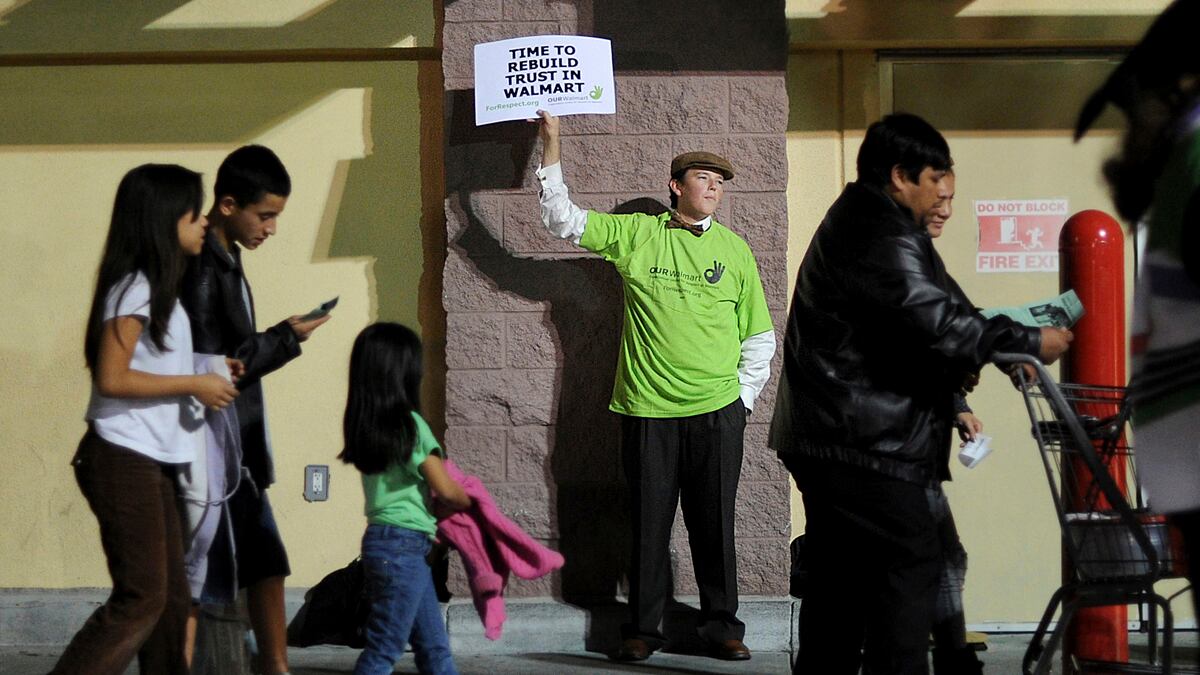Matt Yglesias makes a very interesting point about the difference between Depression-era unionization, and now:
Thinking about worker protests at Walmart and reading a biography of FDR, it's striking how far we are from the sort of context in which the United Auto Workers became a force in the industry. One key moment was a sit-down strike at a crucial General Motors facility in Flint, MI. The strike was crippling to GM's activities because the factory in question was basically a choke-point in the overall supply chain. But it was also crippling to GM's activities because the workers hadn't just walked off the job (where they could be fired and fairly easily replaced at a time of high unemployment), they actually occupied the factory building preventing its use.
Both President Roosevelt and the Governor of Michigan simply refused to get engaged in a violent conflict in order to enforce . . . trespassing laws. I don't think you could count on that same legal tolerance today, mostly because the Supreme Court ruled that sit-down strikes were illegal in 1939, but also because workers are nowhere near as miserable as they were in the early 1930s, when unemployment was running around 25%. Matt goes on to point out an even bigger problem, which is that unlike the 1930s, unions are now respectable institutions with something to lose. They can't just engage in flagrant civil disobedience, because they have assets that they can be sued for, and various certifications that can be yanked.
And even if they were willing to risk it, they'd be left with perhaps the biggest problem of all: how do you take over a Walmart?
An auto factory is an enormous place. But it's a place with a lot of chokepoints. Cordon off a few key machines and the assembly line cannot function. Nor can they be moved. (The famous Flint sit-down strike was actually staged to prevent GM from shutting down the plant and removing the equipment to another location).
There were more than enough autoworkers to shut down any auto plant, as long as the trespassing laws were not enforced. But it's hard to see how even a passionately pro-union Walmart workforce could manage the same feat. A Walmart is a big room with some stuff in it. The average store is about 105,000 square feet, and has 225 employees. If you got the whole staff to stage a sit-down (unlikely, as there are always cranky holdouts in even the most successful organizing drive), each employee would have to blockade 500 square feet of shelf space--a little less if you account for registers, bathrooms, and so forth. There's no bottleneck, no place that's easy to block off. On a busy Saturday morning, any striking workers would be lost in a sea of customers.
To break a sit down, all Walmart would really need to do is hire a bunch of new associates (as I believe is allowed in the case of illegal sit-downs), and unlock the doors. Even if the workers blockaded the doors to keep scabs out, they'd quickly be in a position of having to attack customers to keep the store closed. At which point, any goodwill they'd accumuluated would evaporate, and the heavy hand of the law would wade in. Alternatively, they could start destroying the place, in which case, again, they would look bad and trigger legal action.
Note that I'm not suggesting that modern unions would attack customers or destroy the stores in a labor action; I'm merely pointing out the extreme lengths to which they'd have to go in order to emulate the tactics that unonized the Big Three. Which is another way of saying: not gonna happen.
Update: I see from Twitter that at least a few people were unclear on what I was saying, so let me expand a bit. One reader protested that of course there's a chokepoint: the door. And yes, that's true--very temporarily. Walmart also has a number of rather large truck bays. Even forming a loose human chain across all the entry points for any length of time would probably require the whole workforce, standing in shifts so as not to get exhausted, and with reliefs standing by to provide comfort breaks--if you sit, it would be too easy for the scabs and customers to simply step over you. This assumes that a) you have the entire workforce with you and b) they can be absent from home for a significant period of time. There probably weren't a lot of single parents down at the Flint plant in 1937. Once someone leaves, management--which has the legal right to bar you from their property--will find it pretty easy to prevent you from getting back in.
Management, meanwhile, is not constrained by your stupid door. Management has the legal right to cut new doors any place they want, a process that does not take very long. Management can, if they wish, turn the entire side of the building into a door, which your human chain has to man 24/7--because once management regains one of the entrances, you will have to commit assault to get it back. If you chain the doors shut, or superglue the locks, they have the right to take the doors off of their hinges.
The customers meanwhile, are sort of human shields; they are not agents of management, so if one of them shoves you because you're in the way, management doesn't take the blame. However, if you shove them, your strike becomes front page news, and not in a way that you want. This makes your task of blockading even more difficult.
It also makes it pretty hard to get control of the store in the first place, of course: a lot of Walmarts run 24/7, so there is no point at which your strikers can sneak in and shut the place down without involving innocent third parties in the fracas.
There is great power in simply refusing to move--but the power lies in making it impossible to use the space unless you move, and making it impossible to remove you without using force. This results in unwanted bad publicity . . . but only if you stick to the nonviolence. The first time you shove or hit a customer, or destroy property, you ensure that the public will be cheering as the cops haul you out in handcuffs.
A single person who is sufficiently brave or crazy can lie down in a stamping plant and dare management to push the button. A group of people can cordon off your dies and force management to use nightsticks if they want to get at them. But 225 people sitting down in a Walmart isn't blocking access to anything for very long--no, not even to checkout; mobile checkout is pretty advanced, and Walmart is already testing it.
This is what I meant when I said that stores don't have chokepoints and factories do. An assembly line is a delicate process that can be stopped by holding one of dozens of chokepoints hostage. A store can pretty much only be stopped by holding the whole store.






